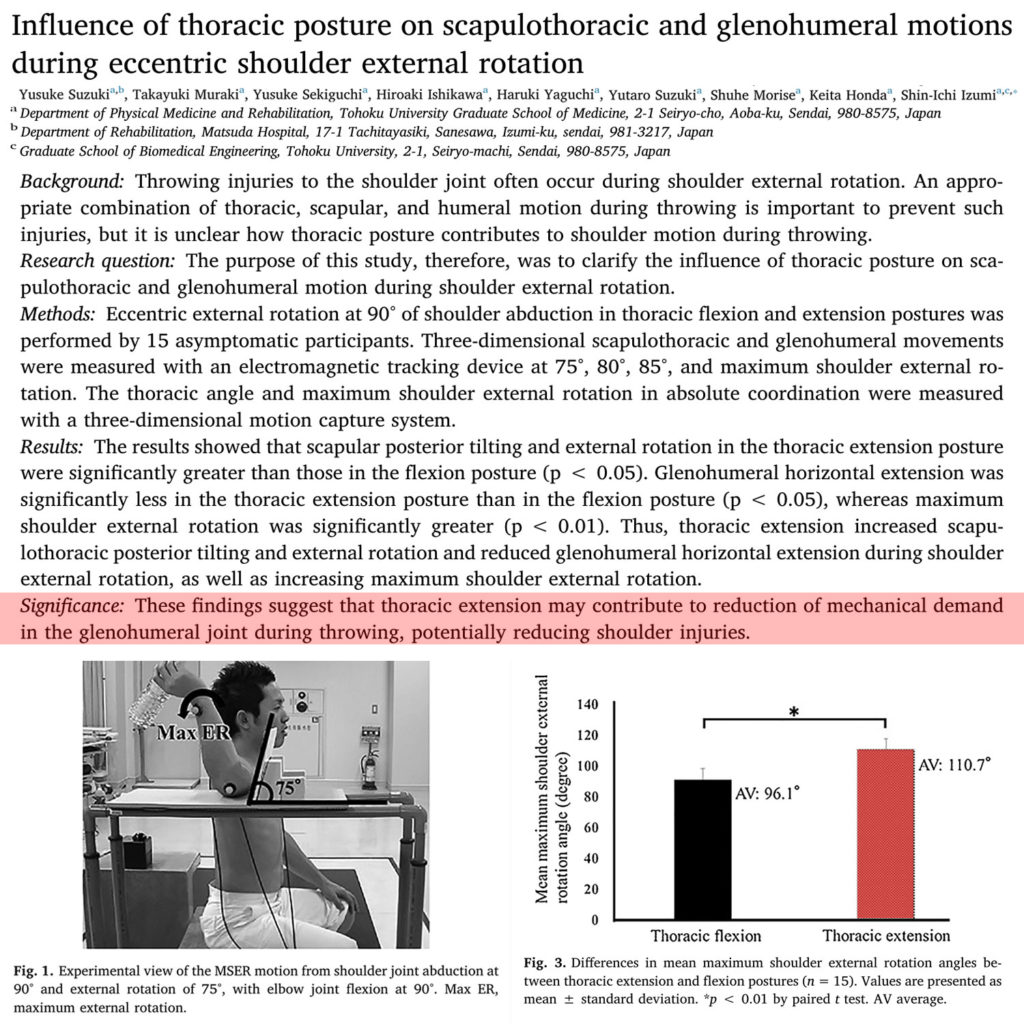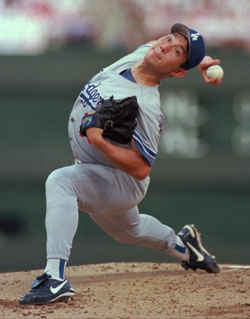
In the study by Suzuki et al, 2019 it looks at how does thoracic extension
The participants used in the case study included 15 healthy right-handed males with an average age, height, and weight of 28 years, 174cm, and 66.9kg. The method involved each participant sitting on a stool with their elbows abducted 90 degrees and resting on a table while holding a plastic water bottle containing 500ml of water in external rotation. The participant was asked to lay his shoulder back externally at 75 degrees of external rotation or to the end range in 1 second time. A 3D motion capture system was used to measure the amount of thoracic extension and shoulder external rotation that was achieved.
Does Thoracic Extension Reduce Arm Injury? YES
The results of the study found that scapular posterior tilting increased only when maximum shoulder external rotation occurred. The posterior tilting was also significantly greater in the thoracic extension posture. The thoracic extension also significantly decreased glenohumeral horizontal extension. A separate study has confirmed that the lower trapezius muscle is a primary mover of the scapular into the posterior tilt position (Turgut, Duzgun, & Baltaci, 2016). If the lower trapezius activation is driving the thoracic extension posture, then this could also be supporting the posterior tilting of the scapular as well. The problem is there is another study that found the lower trapezius muscle was more activated in the slouched sitting posture as opposed to the erect sitting posture (Lee et al., 2016). Another hypothesis that supports poster tilting is a study that found thoracic extension leads to backward rotation of the ribs on the costovertebral joints (Lee, 2003). This backward rotation of the ribs may help the scapular to tilt posteriorly. All this may help thoracic extension reduce arm injury for pitchers.
How Does Thoracic Extension Reduce Arm Injury In Pitching Delivery?

The only limitations in the original study that I found were linked to the method of measuring external rotation without having the influence of thoracic extension or flexion. The real significance of this study suggests that thoracic extension may contribute to the reduction of mechanical demand in the glenohumeral joint during throwing, potentially reducing shoulder injuries. I would assume the study is referring to the study that found increased glenohumeral external rotation has been associated with superior labrum anterior to posterior tears, rotator cuff impingement and increased valgus stress on the elbow (Weber, Kontaxis, O'Brien, & Bedi, 2014). I hypothesize that for a pitcher to implement more thoracic extension into their pitching delivery they need to power more linear trunk energy to optimize this movement. In my experience working with pitchers, the majority just rotate the trunk into pitch release.
Implementing Thoracic Extension into Your Pitching Delivery
The key to implementing more thoracic extension into your pitching delivery is with more momentum down the mound and back and front leg power. The best drills for this is in the 3X Extreme Pitching Velocity Program. The drills are the Chest Open or Chest Up Med Ball and Target Drills. These drills take rotation out of the delivery for the moment to help you build more linear power. Thoracic Extension is the result of a more linear trunk that is powering its energy towards the target. Those who over rotate and even early trunk rotate will pull their trunk into more rotation than extension. If you want to start learning some of the basics of the 3X Pitching Velocity Program and how to build the linear power down the mound then signup for the FREE training series on How to Use the Lower Half.
Reference
- Lee, D. (2003). The Thorax. Physiotherapist Corporation, British Columbia, 41-57
- Lee, S. T., Moon, J., Lee, S. H., Cho, K. H., Im, S. H., Kim, M. Y., & Min, K. H. (2016). Changes in Activation of Serratus Anterior, Trapezius and Latissimus Dorsi With Slouched Posture. Annals of Rehabilitation Medicine, 40(2), 318-325.
- Suzuki, Y., Muraki, T., Sekiguchi, Y., Ishikawa, H., Yaguchi, H., Suzuki, Y., … Izumi, S. I. (2019). Influence of thoracic posture on scapulothoracic and glenohumeral motions during eccentric shoulder external rotation. Gait Posture, 67, 207-212.
- Turgut, E., Duzgun, I., & Baltaci, G. (2016). Effect of trapezius muscle strength on three-dimensional scapular kinematics. Journal of Physical Therapy Science, 28(6), 1864-1867.
- Weber, A. E., Kontaxis, A., O'Brien, S. J., & Bedi, A. (2014). The biomechanics of throwing: simplified and cogent. Sports Medicine and Arthroscopy Review, 22(2), 72-9.

